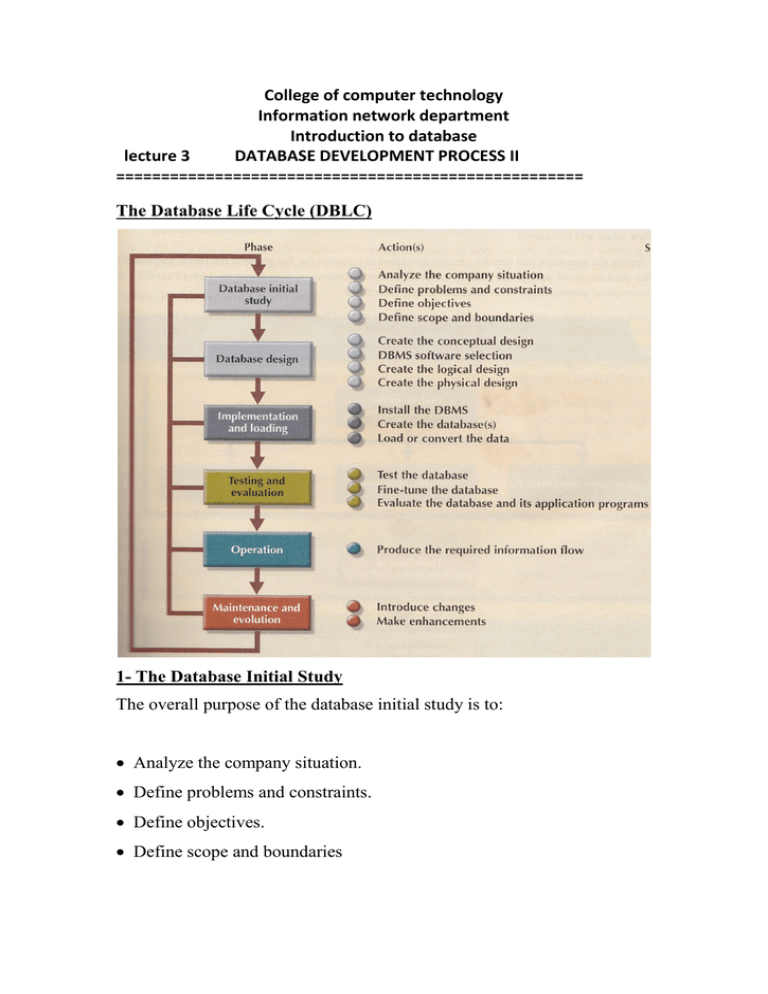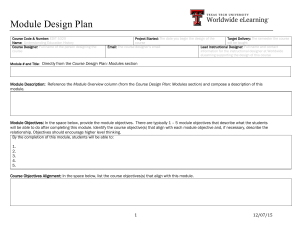College of computer technology Information network department Introduction to database
advertisement

College of computer technology Information network department Introduction to database lecture 3 DATABASE DEVELOPMENT PROCESS II ==================================================== The Database Life Cycle (DBLC) 1- The Database Initial Study The overall purpose of the database initial study is to: Analyze the company situation. Define problems and constraints. Define objectives. Define scope and boundaries Analyze the Company Situation The following issues must be resolved: What is the organization's general operating environment, and what is its mission within that environment? What is the organization's structure? Define Problems and Constraints The designer has both formal and informal sources of information. If the company has existed for any length of time, it already has a system in place (either manual or computer-based). How does the existing system function? What input does the system require? What documents does the system generate? By whom and how is the system output used? studying the paper trail can be very informative. In addition to the official version of the system's operation, there is also the more informal, perhaps more real version; the designer must be shrewd enough to see how these differ. Define Objectives The DB designer must begin to address the following questions: What is the proposed system's initial objective? Will the system interface with other existing or future systems in the company? Will the system share the data with other systems or users? Define Scope and Boundaries Scope defines the extent of the design according to operational requirements. Boundaries are imposed by existing hardware and software, the designer can choose the hardware and software that will best accomplish the system goal. 2- Database design As you examine the procedures required to complete the design phase in the DBLC, remember these points: The process of database design is loosely related to the analysis and design of a larger system. The data component is only one element of a larger information system. The systems analysts or systems programmers are in charge of designing the other system components. Their activities create the procedures that will help transform the data within the database into useful information. The database design does not constitute a sequential process. Rather, it is an iterative process that provides continuous feedback designed to trace previous steps. The following figure explain Database design process 3- Implementation and loading. Install the DBMS Create the Database(s) Load or convert the data 4-Testing and evaluation 1. Test the Database you must test for at least the following: Physical security Password security Access rights Audit trails Data encryption Diskless workstations 2-Fine _Tune the Database 3- Evaluate the Database and its application programs 4- operation Once the database has passed the evaluation stage, it is considered operational. At that point, the database, its management, its users, and its application programs constitute a complete information system. 5- Maintenance and evaluation The database administrator must be prepared to perform routine maintenance activities within the database. Some of the required periodic maintenance activities include: Preventive maintenance (backup) Corrective maintenance (recovery) Adaptive maintenance (enhancing performance, adding entities and attributes, and so on) Assignment of access permissions and their maintenance for new and old users Generation of database access statistics to improve the efficiency and usefulness of system audits and to monitor system performance Periodic security audits based on the system-generated statistics Monthly, quarterly, or yearly system usage summaries for internal billing or budgeting purposes



